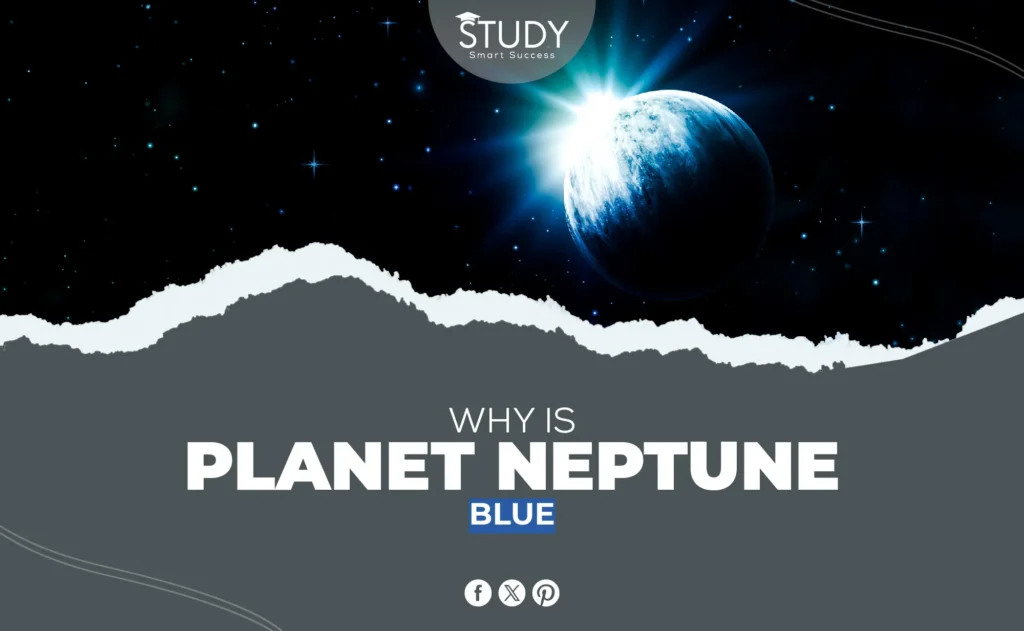Introduction
The eighth planet from the Sun, Neptune, is one of the most beautiful things in our solar system due to its deep blue color. This color reveals the planet’s complicated atmospheric chemistry and harsh physical circumstances. Explore why is planet Neptune blue to learn about its composition and the cosmos. Astronomers researching our solar system’s farthest planets need Neptune’s bright blue color.
Astronomers investigating the outer planets must understand why Neptune is so blue. This extensive examination delves into the scientific phenomena that make Neptune blue. Researchers can learn more about Neptune and other planets by studying its atmospheric gases’ interaction with sunlight and physical features.
Neptune’s Composition
Neptune’s atmosphere consists of diverse gases, mainly hydrogen and helium. It also contains more intricate molecules, such as methane and small amounts of icy compounds.
Primary Gases: Neptune’s atmosphere consists mainly of hydrogen and helium, the lightest and most plentiful elements found in the universe. These elements form the fundamental structure of Neptune’s gaseous envelope.
Role of Methane: Considering how little methane is in the air, it has a much bigger effect on Neptune’s color than it should. It is important because it takes in red and infrared light but lets blue light bounce back, making Neptune look blue.
Additional Compounds: Various gases and ices, such as water vapor and ammonia, are present in lesser quantities and play a role in the atmosphere’s overall pressure and thermal dynamics. However, their impact on color is minimal.
Role of Methane in Neptune’s Color
Because of the way it absorbs light, methane is the main chemical that gives Neptune its blue color.
Selective Absorption: The only color of light that methane molecules don’t receive is blue light, which they reflect. This pattern of absorption and reflection is significant for Neptune’s blue color.
Enhanced Scattering: The molecular structure of methane significantly increases the scattering of blue light. This effect causes short-wavelength light to scatter more efficiently than long-wavelength light.
Comparison with Uranus: Even though Uranus has methane, its atmosphere is a different blue. Variations in atmospheric pressure, temperature, and perhaps other constituents may affect scattering and absorption differently.
Neptune’s Atmosphere and Light Scattering
Light is scattered by Neptune’s atmosphere, which is what gives it its blue color:
Rayleigh Scattering: This scattering process influences particles smaller than the wavelength of light. It primarily scatters the shorter, blue wavelengths more effectively than the longer ones.
Effect of Atmospheric Pressure: The atmospheric pressure on Neptune is quite high, leading to a denser atmosphere. This density amplifies the Rayleigh scattering effect, producing a more intense blue hue in visible light.
Uniformity of Color: Neptune showcases a striking deep blue hue on its surface, setting it apart from the diverse colors of other gas giants such as Jupiter and Saturn. This distinct coloration results from its uniform composition and consistent light scattering in its atmosphere.
Neptune’s Location in the Solar System
How Neptune’s atmosphere reacts with sunlight and changes its color depends on where it is in the solar system:
Distance from the Sun: The significant distance of Neptune from the Sun, approximately 30 astronomical units, results in a much lower amount of sunlight reaching it. This reduced sunlight influences the way its atmosphere interacts with and disperses light.
Solar Influence: The reduced sunlight brightness highlights Neptune’s atmosphere’s unique characteristics. This makes the effects of methane’s light scattering more noticeable in shaping its overall hue.
Observational Effects: Neptune appears dimly in the sky due to its vast distance from Earth. This challenges astronomers to employ sophisticated telescopes to analyze its atmospheric characteristics effectively.
Historical Observations and Studies
The hue of Neptune has captivated attention since it was first discovered. Past and contemporary observations have significantly contributed to our understanding of this planet.
Early Telescopic Observations: Since its discovery in 1846, Neptune’s striking blue hue has been thoroughly recorded, leading to numerous theories regarding its atmospheric characteristics.
Voyager 2 Data: The Voyager 2 flyby in 1989 yielded crucial data, delivering the first detailed images of Neptune. It confirmed methane’s presence and enriched our understanding of atmospheric scattering processes.
Modern Studies: As Hubble and other telescopes continue to observe Neptune’s atmosphere, scientists can better comprehend its color dynamics.
Comparative Analysis with Other Planets
Putting Neptune next to other planets makes its deep blue color stand out:
Jupiter and Saturn: The atmospheres of these planets are abundant in ammonia and hydrogen sulfide. This composition scatters a broader range of light, leading to a more subdued and diverse array of colors.
Varied Colors of Uranus: The pale blue hue of Uranus highlights the nuanced variations in atmospheric conditions that exist between it and its counterpart. This distinction is evident even with their comparable atmospheric makeup.
Mars and Venus: The striking variations in color between planets such as Mars and Venus highlight the essential influence of atmospheric makeup on a planet’s appearance. This showcases how different atmospheres can dramatically alter visual traits.
Conclusion
Neptune’s vivid blue tint helps explain the outer solar system’s atmospheric dynamics. By examining its hue, scientists learn how atmospheric conditions can change greatly with distance from the Sun, planetary composition, and other environmental factors. Neptune’s look reveals its atmospheric mysteries and helps us comprehend other planets in our solar system and beyond.


